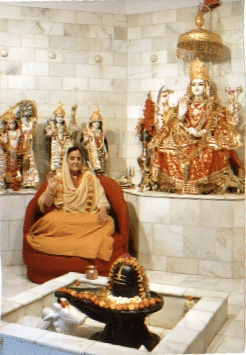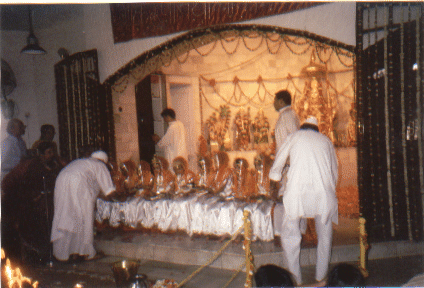Karunamai
Maa
The
benevolent mother
Piyaray Lal Raina

Karunamai
Maa in Ashram Temple (1999)
On October 28, 2000, Hindu community and particularly
Kashmiri Pundits lost one of it modern day saints
who had achieved siddhi in her lifetime by
taking samadhi in New Delhi. It was indeed
a sad day for the followers of Karunamai maa.
Background
Karunamai
Maa was born in 1913 in a devout Kashmiri
Pandit family of Kichloo’s on Nag Panchami and
was named Bimla. The family priest Surikant Joshi
of Bijbehara in Kashmir who had himself achieved siddhi
by worshipping Param Shakti Ragnnya Bhagwati
(Khir Bhawani) initiated her into shakti sadna
at an early age. She wanted to be a sanyasin
but her guru advised her to live a normal grehesti
life. She therefore was married in a well to do
Kashmiri family of Channas in New Delhi.
Although
she lived a life of common grahesti woman with her
three sons, she was always engaged in attending
and conducting satsangs in New Delhi for
about 30 years. Many who attended her satsangs
became her dedicated disciples and started calling
her Karunamai Maa - the benevolent mother.
Shree
Karunamai Maa Shakti Peeth
Until
1989, she would regularly go to Kashmir (Khir
Bhawani) for meditation. In 1989, she decided to
establish a shaktipeeth at a place known as
Sanp ki Nangli near Sohna in Gurgaon District of
Haryana State (about 50 kms south of New Delhi).
This shaktipeeth came to be known as Shree
Karunamai Maa Shakti Peeth. She procured about
10 acres of land there and with the help of her
disciples she constructed a beautiful temple
dedicated to Maa Durga (Ragnya) with a big
hall which can accommodate up to 500 attendees at
a time. She also built a small residential cottage
for herself where she lived with her chief
disciples. Additional construction was done to
accommodate pilgrims, a library, a medical clinic,
and sevaks. The land around the temple was
converted into a beautiful garden with flowers and
greenery. Fruit trees such as mango, amrud,
papayas, lemons were planted. To meet requirements
of eatables for the residents wheat and vegetables
were cultivated. A number of cows were added to
meet the requirements of milk and milk products.
Neem trees have been grown all round the periphery
for providing clean and calm environment. The
devotees feel enchanted and spirited at the very
sight of this Ashram.
Karunamai
Maa had achieved siddhi at a young age. She
preferred to be left alone to meditate and enjoy
the divine bliss of which she was a symbol. This
was the primary reason she chose to live in a
remote rural place. But her devotees were always
looking for her. Everyday the disciple cars were
lined up outside the Ashram gate. On auspicious
occasions, like Navratras, special arrangements
for devotees and car parking had to be made. She
never installed a telephone in the Ashram as she
thought it would further distract her peace.
Spirituality
and Beliefs
Karunamai
Maa believed in purity in all phases of life. She
taught that cleanliness of mind is as essential
for the spiritual growth as physical one. She
adored deities in temple with choicest dresses and
ornaments and was herself dressed well. She lived
by the principle of "sound mind in a sound
body". For achieving siddhi, she favored the
route of Japs rather than ritualistic puja.
One would see her always reciting Jap mantras with
a Jap Mala concealed in a small pouch in her right
hand even when she was talking to her devotees.
She insisted on praying daily preferably loudly in
her melodious voice to elevate her spirituality
before performing Japs. She had adopted Kashmiri
prayers for recitation in Ashram. Thus one would
hear recitation of prayers like:
Ganesh
Prayer
Hemja
Sutam Bujam Ganesham Ish Nandnam
Kalpavraksha
Bhaktaraksha Namostutey Gajaananam
Gauree
Prayer
Om
Leela Rabda Sthaapit Lupthakhil Lokaam
Gauree
Ambaah Ambur Haakeem Hameeday
Bhannamsahasrastutih,
Bahuroop Garbpath and Mahimnapar ( with the
beginning of Aadinam agdam divyam) were
daily recited. The above prayers are purely of
Kashmiri origin and are not typically recited
outside of the Kashmiri Pundit families. Most of
her devotees were non-Kashmiri’s and they would
recite them verbatim as was done in Kashmir.
During
the two annual Navratras, special prayers were
held with a daylong havan’son Durga Ashtami.
Durga Mata was specially propitiated as a fountain
of shakti by offering homs (svaha) as established
in Bhavani Shestranavali. Karunamai Maa had great
faith in Maa Durga. During the nine days of
Navratras, she would often remind her disciples
that Maa Durga is in a mood to forgive sins and
bestowing blessings and therefore they should do
as much Japs as possible over 125,000 limit.
During Havans, prasad was distributed to devotees
where Kashmiri style food such as plain rice, dam
aloo, chok vagun, moong ki daal with nadru etc
would be served to thousands who would attend.
Ashram has raised a permanent platform for
distributing prasad to a large gathering.
Benevolent
Mother
Karunamai
Maa was a benevolent person at heart. Despite her
old age and indifferent health, she never refused
to attend to the prayers of those who came to seek
her blessings. She would always give a patient
hearing to them and made it a point to see that
they left satisfied. She would give them a small
mantra for a jap and then she kept track of the
progress of the individuals problem. If no
progress was reported she would give a different
mantra. She called her devotees by their first
name. To give maximum satisfaction to her devotees
she made it a point to apply tilak and tie
nariwan(mavli) round their wrists herself in spite
of her physical discomfort towards her old age.
She had a tradition of going to Haridwar along
with her devotees for few days and after having a
bath in the river Ganga along with them she would
offer extensive pooja and made everyone
participate in it. It used to be a great event for
her devotees and they eagerly waited for this
opportunity. New disciples were initiated with
mantras at this time. She felt very sad for
Kashmiri Hindus who suffered so much for no fault
of theirs and offered prayers for their return to
their motherland.
Social
Activistism
She
thought it her duty to do something for the poor.
She opened a Homeopathic and Ayurvedic clinic in
the ashram where she invited leading doctors to
treat the poor. Free medicines were distributed.
For the old who suffered from the partial loss of
vision she organized camps for their cataract
operations. A center was opened providing sewing
training to ladies. Weekly coaching classes were
held for children to teach them alphabets and also
helping in doing their home- work. She had a deep
love for children and she laid a park for them in
the ashram premises in which swings and seesaws
slides were fixed. Annual sports day for village
children was held. Winners were presented prizes.
During
Navratra celebrations, children were encouraged to
recite mantras and were rewarded. On Navratra
ashtami, nine small girls were selected among
those who came with their parents. They were
dressed representing nine goddesses and were
carried in a procession to temple, their feet were
washed by Maa herself. After performing their
pooja, they were sent away with good money as dakshina.
The
excitement on the faces of children and their
parents as well was a sight to be seen. On these
occasions, she distributed lot of new clothes
among the poor. Every year she made special
arrangements on a particular day to invite local
village people for a pooja for their welfare that
was followed by a lunch. This was her way of
keeping local people in touch with all the
activities in the ashram. They always attended in
large numbers.
Other
interests
Maa
wrote hindi poetry. A collection of her poems has
been published under the title Maa Prasad.
One finds a touch of Kabir in her poetry. For
example:
Gyan
bakti ke bina kahan miley nirman
Goru
charan seva bina nahi miley bhagwan
Bool
per bool kare apne ko dubayey
Neki
kar tere kam aayey dubey koun bachy
Maa
had a hypnotizing melodious voice which kept
audience spellbound when she recited prayers or
her poems. All these have been recorded. She
enjoyed music and thus encouraged all those who
could sing or play music.
Maa
liked travelling. She traveled regularly to US,
Canada, Europe, Hong Kong etc. As a matter of
fact, she returned from a two-month trip of
Germany and France on September 1, 2000.
Future
Plans for Ashram
To
take care of Ashram after her taking Samadhi Maa
had already performed an elaborate abhishek for
installing a young sansasi who had renounced his
career as a Chartered Accountant as her heir. She
gave him the new name Nand Baba who posses all the
divine qualities of Nand and with the blessings of
Maa he will surely carry forward the mission of
Karunamai Maa’s dreams.
Those
who she touched in her life have been blessed. Let
us all pray for her everlasting peace and remember
her benevolent presence amongst us.

Kanik
Puja celebration in the Ashram (2000)
| 















No one has commented yet. Be the first!